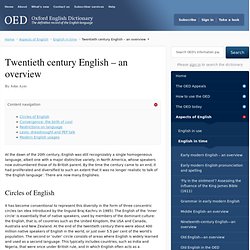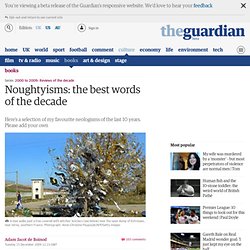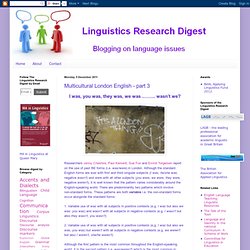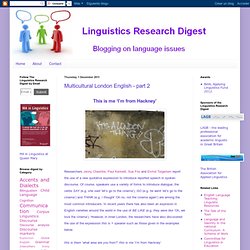

Twentieth century English - an overview. At the dawn of the 20th century, English was still recognizably a single homogeneous language, albeit one with a major distinctive variety, in North America, whose speakers now outnumbered those of its British parent.

By the time the century came to an end, it had proliferated and diversified to such an extent that it was no longer realistic to talk of ‘the English language’. There are now many Englishes. Circles of English It has become conventional to represent this diversity in the form of three concentric circles (an idea introduced by the linguist Braj Kachru in 1985). Noughtyisms: the best words of the decade. As a collector of words, here's my list of the best the decade had to offer, taken from my book, The Wonder of Whiffling.

These words and expressions were all coined in particular parts of the world in specific years: they're principally slang and jargon; catching on, but still waiting to be formalised into our dictionaries. 2000witches' knickers (Ireland) shopping bags caught in trees, flapping in the wind get corrugated ankles (UK campus) to get drunkglomp (US campus) to jump and hug someone from behind drink-link (UK campus) a cash dispenser 2001goat heaven (Caribbean) a state of unfettered freedom, enjoyment, indulgence evoking both bliss and excess 2009generica (US) features of the American landscape (strip malls, motel chains, prefab housing) that are exactly the same no matter where one iscatch a falling knife to buy a stock as its price is going down, in hopes that it will go back up, only to have it continue to fall.
Multicultural London English - part 3. I was, you was, they was, we was .…….. wasn’t we?

Researchers Jenny Cheshire, Paul Kerswill, Sue Fox and Eivind Torgersen report on the use of past BE forms (i.e. was/were) in London. Although the standard English forms are was with first and third singular subjects (I was, he/she was, negative wasn’t) and were with all other subjects (you were, we were, they were, negative weren’t), it is well known that the pattern varies considerably around the English-speaking world. There are predominantly two patterns which involve non-standard forms. These patterns are both variable i.e. the non-standard forms occur alongside the standard forms: 1. 2. Although the first pattern is the most common throughout the English-speaking world, it is the second pattern (i.e. was/weren’t) which is the most common in Britain (note, though, another pattern in north-west England) so that many people in Britain today will say things like we was busy; she weren’t at home; he was angry, weren’t he?
Multicultural London English - part 4. A apple, a orange and a change of rule Researchers Jenny Cheshire, Paul Kerswill, Sue Fox and Eivind Torgersen report on the use of the indefinite article (a/an) and the definite article (the) before words beginning with a vowel.

In standard English the forms are roughly a and thuh before a consonant e.g. a pear, ‘thuh’ pear, and an and thee before a vowel e.g. an apple, ‘thee’ apple. Older speakers in conform to this standard English pattern. However, some recent studies have shown that young people in are not varying their use of the article forms but are using the pre-consonant forms in both contexts i.e. a pear but also a apple and ‘thuh’ pear but also ‘thuh’ apple. The results from the Multicultural London English study confirm this trend.
The researchers state that this is another feature of language change which has probably come about due to the language contact situation in. . , J., Kerswill, P., Fox, S. and Torgersen, E. 2011. Multicultural London English - part 2. This is me ‘I’m from Hackney’ Researchers Jenny Cheshire, Paul Kerswill, Sue Fox and Eivind Torgersen report the use of a new quotative expression to introduce reported speech in spoken discourse.

Of course, speakers use a variety of forms to introduce dialogue; the verbs SAY (e.g. she said ‘let’s go to the cinema’), GO (e.g. he went ‘let’s go to the cinema’) and THINK (e.g. I thought ‘Oh no, not the cinema again’) are among the most common introducers. The trench talk that is now entrenched in the English language. Anti-Woman Suffrage Pamphlet, 1910.